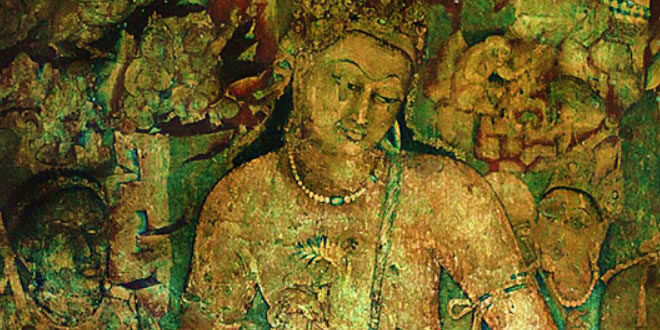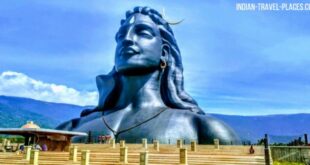| Name: | Aurangabad – “City of Gates” |
| Location: | Aurangabad, Maharashtra state, India |
| Climate: | Summers: 450 C (Max), 280 C (Min) | Winters: 250 C (Max), 130 C (Min) |
| Best Time to Visit: | October to February |
| Nearest Airport: | Aurangabad Airport (Chikkalthana Airport) |
| Railway Station: | Aurangabad Railway Station |
| Must Visits: | Ajanta Caves and Ellora Caves, Bibi ka Maqbara, Ghrishneshwar Temple, Aurangabad Caves, Soneri Mahal, History Museum, Gautala Wildlife Sanctuary |
| Language Spoken: | Marathi, Urdu, Hindi and English |
| STD Code: | 0240 |
Aurangabad is a remarkable city in the Indian state of Maharashtra. Aurangabad is also referred to as “City of Gates”, because the whole city is bounded by 52 gates. It is located in the administrative district of Aurangabad and spread over an area of about 200 square kilometers. The city is located at an altitude of 513 m above the average sea level and thus, features a semi-arid climate with hot summers (April to June) and mild cold winters (October to February). The monsoon season (June to September) is quite pleasant too, with an average annual rainfall of about 725 mm. The best time to experience the beauty of Aurangabad is from October to February. It is, by far, the most significant city of Maharashtra tourism, as it is home to two UNESCO World Heritage Sites – The Ajanta Caves and the Ellora Caves and thus attracts thousands of domestic as well as foreigner travelers every day.
Named after the Mughal Emperor Aurangzeb, Aurangabad literally means “Built by the Throne”. However, Aurangabad was not founded by Aurangzeb, but by Malik Ambar by in 1610 A.D. After his death in 1626, this city was under the control of his Fateh Khan who named it, Fatehabad. Late in 1633, it was conquered by Mughals. In continuity of the empire, Prince Aurangzeb made it his capital and changed city’s name to Aurangabad. In 1660, Aurangzeb’s son built Bibi Ka Maqbara (replica of Taj Mahal) in the honor of his mother Dilras Bano Begam. In the year 1720, Aurangabad was taken over by Nizam-ul-Mulk Asif Jah and was made capital city by him. Including these historical events, the year 1857 also was one of the most eventful years in the history of Aurangabad, as the first revolt against British Raj was started herein.
Aurangabad has a very well urbanized transport system that caters the flow of tourist traveling through the city daily. It is one of the major silk and cotton textile production centres of India. Paithani silk sarees is the gift of Aurangabad. Apart from these textile industries, it is a hub of many automobile and electronic industries. The city has a huge collection of historical and architectural marvels, which are praised around the world. Bibi ka Maqbara, Ghrishneshwar Temple, Daulatabad, Aurangabad Caves, Soneri Mahal, History Museum, Gautala Wildlife Sanctuary and Siddhartha Garden are just few of them. Due to its potential tourism capacity, Aurangabad was recently honored with the title of being “Tourism Capital of Maharashtra”.
Best Time To Visit Aurangabad
Aurangabad, the erstwhile seat of the Mughal Empire and the heritage hub of Maharashtra, is better known as the ‘City of Gates’. Wadded with ample historical relics, this medieval city was once home to as many as 52 gates. However, today only 13 of them remain. World-famous for its two unique UNESCO heritage sites, Ajanta and Ellora that serves as a source of great inspiration for the globe-trotters and budding historians, Aurangabad indeed tops the itinerary list of every curious wanderer. Chocked up with monuments, gates, caves and depositories that give you a glint into the rich history of this dusty city, a visit to Aurangabad is like a trail down the pages of India’s imperial history. Endowed with a signature culture that is unique to the place, a visit to the city is just an ideal way to get up, close and personal with the local cuisine, customs, literature and cosmopolitan population of the city. The indwellers here take great pride in flaunting their Urdu literature and whetting up your appetite with their lip-smacking Mughlai fare. Aurangabad enjoys a relatively moderate climate with no drastic difference in its temperature. Navigate through the article to know more on when to go to Aurangabad to make the most of your trip.
When To Go To Aurangabad
Weather
Like most other places in Maharashtra, Aurangabad experiences a semiarid climate. The summers are usually scorching hot and sticky with the mercury levels darting beyond 40oC during the peak summer months of March, April and May, when the weather is at its warmest here. Monsoon sets in the month of June and last until early October with rampant rainfall ameliorating the effect of the blazing heat. Winters here, which last from November to February, are much cooler with the temperature dipping as low as 10oC during extreme cold days.
Opting For Your Favorite Season
If you enjoy summers and do not mind soaking up sun while you rubberneck down the city streets, then a visit during the month of February would just suit you fine. The weather conditions during this time is fairly tolerable, thereby, making it an ideal time for sightseeing or a day-long excursion trip. The monsoons here are a big relief from the summer sun. If the thought of exploring a rain-washed Aurangabad intrigues you, then visiting the city anytime during the monsoon months of August, September and October would be your ideal bet. However, don’t forget to carry umbrellas and raincoats to protect yourself from the torrential rains. Winters in Aurangabad are absolutely marvelous. The city experiences a pleasant climate during the winter months of November to February and is the best time to explore the city’s attractions.
Best Time To Visit Aurangabad
The best time to visit Aurangabad is during the winter months of November to February when the city is packed with domestic and international tourists who flock here to visit the famous Ajanta and Ellora caves. An ancient old city with rich history and culture, Aurangabad is indeed a numero uno vacation spot, with its number of monuments, gates, museums and caves the city reminding you of its bygone era. Although Aurangabad’s culture is heavily influenced by the Muslim customs and traditions, it is incredible to see two diverse cultures living in great harmony in this city.
History
Famous for its iconic rock-cut caves of Ajanta and Ellora, Aurangabad has earned itself quite a distinction in Indian history. A trip to this spectacular city leaves you stunned with its impressive spate of monuments, caves, religious festivals and authentic food that amplifies its attractions to the hilt. Thus, if you want to feel the rich essence of the royal past, there is no better place than Aurangabad. From centuries old temple to beautiful Mughal monuments to the mesmerizing caves of Ajanta and Ellora, every piece of architecture narrates you the exquisiteness and glory of the land. Although the land was dominated by several Hindu rulers in the past, the city underwent rapid growth under the glorious rule of Mughals. Many of the shrines and age old walls of the city built by Aurangzeb depict the splendor of Mughal architecture. The beautiful amalgam of historical sites with cosmopolitan culture surely makes the place a must visit tourist destination. To know more about Aurangabad and its majestic history go through the article below.
Aurangabad History
Ancient History
Formerly, Aurangabad was home to many noted dynasties including Satavahanas, Chalukyas, Rastrakutas and Yadavas. Among the Hindu rulers, the Mauryans left a lasting impression on the historical and religious background of the place. It was during their reign that a plethora of Buddhist cave temples were erected in and around the place. The world famous Ajanta and Ellora caves of the place are admired even today for their beautiful amalgam of Hindu, Jain and Buddhist architecture.
Spectacular Muslim Rule
Under the Muslim rule, Aurangabad experienced a spectacular growth. Some of the noted Muslim rulers who dominated the place were Tughluqs, Mughals and Nizams of Ahmedabad and Hyderabad. The glory of Muslims started with Malik Ambar, the prime minister of Ahmednagar. As a successor, his son Fateh Khan established his kingdom here and named it as Fatehpur in 1626. Attracted by the strategic location of Fatehpur, Mohammad Bin Tughlaq tried to shift his capital from Delhi to this city. With time, Fatehpur came under the reign of Aurangzeb who changed its name to Aurangabad in 1653. Acknowledging the supreme power of Maratha rulers, Aurangzeb used Aurangabad as his weapon to suppress the rising rule of Shivaji. However after the death of Aurangzeb in 1707, Nizams of Hyderabad took over the control of the city. The legendary Nizams maintained and controlled the city until it was merged with Maharashtra in 1956.
Great Revolt Of 1857
With the rising power of British in India, people across the country revolted against the colonial power, demanding more freedom, democratic powers, social and political reforms. Just like any other part of India, Aurangabad experienced the heat of 1857 revolt, which is often known as first war of Indian Independence. Aurangabad being one of the important cities in history, the place experienced a number of military disturbances during this time.
How To Reach Aurangabad
Named after the infamous Mughal emperor Aurangzeb, Aurangabad is a major tourist attraction in the state of Maharashtra. Being wadded with copious historic attractions and heritage sites, Aurangabad is flocked by the wanderlusts all the time. A trip to Aurangabad is like stepping into a time machine that takes you back in time, to the Mughal period. As you wander about the city, take a sneak-peak into its history that gives you a detailed account on the Mughals and the Marathas who dominated this land and how they had left an indelible impression on the city’s culture and people. While you are in the city, don’t miss the opportunity to pig out on local delicacies like ‘Nana Qalia’ and ‘Tahri’, which are the most popular mouth-watering treats in Aurangabad. If you are someone with a keen eye for traditional art forms, then you might enjoy catching a glimpse of the local centuries old weaving technique known as Himroo. Aurangabad has many such intriguing things that capture the quintessence of the place. Since the place has earned a reputation as the ‘tourism capital of Maharashtra’, Aurangabad is well connected and easily accessible from all parts of the state. Read through the article to know more about how to reach Aurangabad.
Traveling To Aurangabad
By Air
Chikkalthana Airport, located around 10 km away from the heart of the city, is well linked to the important metros in the country such as Mumbai, New Delhi, Pune, Udaipur, Jaipur and Nagpur, at a regular basis. The city does not have an international airport and operates only domestic flights. Domestic air carriers like Air India, Jet Airways, JetLite and Kingfisher Airlines operate from this airdrome.
By Rail
Aurangabad junction is not located in the main route. The closest railway junction to the city is that of Manmad located 120 km away from the city centre. Once you reach the Manmad station, you will find several trains that ply to Mumbai, Nagpur, Delhi, Hyderabad Pune, Nasik and many other important destinations. For people traveling from Mumbai to Aurangabad, passengers can opt to commute through the Aurangabad-Mumbai Jan Shatabdi, which is said to be the best means of transport for people traveling to the city.
By Road
Aurangabad is well connected by roads. The NH211 route connects Dhule and Solapur to Aurangabad. For those traveling from Mumbai can take the Nagpur-Aurangabad-Mumbai express highway. Besides this, the city is connected by state highway to the cities of Pune, Ahmednagar, Nagpur, Mumbai and many other destinations in Maharashtra. Commuting through means of road is cheaper and far more convenient. The Maharashtra State Road Transport Corporation has taken up the initiative to improve the transportation in the city by providing more buses. The transport authorities have also started the inter bus services which connect different parts of the city easily.
Places To Visit
A trip to Aurangabad is possibly the best way to get up, close and personal with the historical heritage of the city. Erstwhile, the royal seat of Mughal Empire’s sixth descendent, Aurangzeb, today Aurangabad primarily serves as the backdrop of two of world’s most renowned heritage sites, the rock-cut caves of Ajanta and Ellora. Apart from these ravishingly beautiful stone caves that seem inspired from Jatka Tales, Aurangabad is wadded with innumerable monuments, cave temples, gardens and lots more that serves as a part of its major attractions. Apart from rubbernecking, you can also sample some lip-smacking Mughlai cuisine here that is just mind-boggling. What’s more, every year the tourism department organizes the Ellora festival that showcases the best talent in the country and is just another added attraction of this place. Make sure to stop by the city during this festival time to witness some spectacular performances of talented artists along with an opportunity to dive into the local cultural in the region. For shopaholics, do step into the local bazaar to shop for Himroo shawls and the exquisite Paithani sarees that is a synthesis of gold and silk thread weaves found in bright colorful and in traditional patterns. Scroll through the article to find the tourist attractions in Aurangabad.
Tourist Attractions In Aurangabad
Ajanta Caves: Aurangabad
The Ajanta caves are a magnificent structure that depicts the different stages of Lord Buddha. A UNESCO world heritage site, the caves are said to be a 2nd century BC monument. The grottos came to light only in the 19th century when an English officer was tracking down a tiger. During his trail, he discovered the caves hidden away in the middle of a thick forest. Built by a group of Buddhist monks, the Ajanta Caves consists of 29 caverns, each being a brilliant piece of work of art. The caves contains several sophisticated and exquisite inscriptions, sculptures and paintings that are said to be pictorial depictions from the Jataka Tales. Many historians believe that the monks used the caves as a learning center and for preaching and practicing the principles of Chaityas and Viharas that was common ritual among the Buddhists. The Ajanta caves are a benchmark among the Buddhist-styled architectures that cannot be witnessed elsewhere in the world.
Ellora Caves
Built during 350 A.D, the Ellora caves is another iconic structure in the city. The caves are said to be a composition of Hinduism, Buddhism and Jainism devotion. Located 29 km away from the city, the Ellora caves are the most excellent illustration of cave sanctuary in India. The Kailasa temple is believed to be carved out of a single block of stone. This monolith is said to be the world’s largest, as the gateway, pavilion, assembly hall, sanctum and the tower is said to be all carved from the same stone. The Ellora caves have many such fascinating and complex sculptures that display the architectural skill and design of the medieval period. Just like the Ajanta caves, the Ellora grottos are also world renowned for their beautiful carved edifices.
Ghrishneshwar Temple
Located close to the Ellora caves, the Ghrishneshwar temple is yet again another architectural wonder in the district. Built in the 18th century, the shrine is eulogized for its structural design and intricate stone work. The temple is presided by Lord Shiva and is an important place of worship for all Hindu devotees. Built by Rani Ahillyabai Holkar, a Maratha princess, this temple is an impressive work of art.
Bibi ka Maqbara
The Bibi ka Maqbara was built by Aurangzeb’s son in honor of his beloved mother Begum Rabia Durani. This structure was designed by Ata Ullah who constructed the memorial on the lines of the Taj Mahal. Many historians state that the monument is a facsimile of the Taj Mahal but the edifice was erected out of sandstone with floral designs plastered on the entryway. Constructed in 1679, the Bibi ka Maqbara is situated within the city limits.
Soneri Mahal
The Soneri Mahal was built by a Bandalkand chief who accompanied Aurangzeb when he entered the region. Inside the Mahal, you can take a quick sneak-peek at the paintings that have gold finishing to it. Soneri Mahal stands as a testimony to the lost grandeur of the Mughal era in the region. Today, however, the place functions as a museum that exhibits Indian pottery, traditional robes, antique collections, sculptures and variety of other artifacts. The Soneri Mahal is nestled within the Dr. Babasaheb Ambedkar Marathwada University Campus, which is located close to the city walls.
Siddharth Garden
The Siddharth garden is a beautiful promenade in the city of Aurangabad. The garden has a variety of trees and flowering shrubs that are well-laid down in the park. Siddharth garden also has a zoo that shelters a variety of animals including lions, tigers, leopards, crocodiles, snakes, civet cats, hyena, fox, porcupine, emu and deer. The garden is a popular attraction among the local people and often seen as an ideal picnic spot in the region.
Shopping In Aurangabad
If you thought that Aurangabad, like all other medieval cities, is all about heritage grottos, historical relics and lip-smacking Mughlai fare, then you are surely in for a big surprise! Besides the historians and the epicureans, Aurangabad has much to offer to its shopaholics as well. An A-one tourist destination in Maharashtra, Aurangabad is world-famous for its shopping lanes that are wadded with shops selling regional specialties like top-notch weaves, exquisite silverware, semi-precious stones and lot’s more. Whether you like to binge on fine fabrics or get hold of some semi-precious stones, the lanes of Aurangabad has everything to catch your fancy. The best time to visit Aurangabad is between October to March when the weather is cool and most pleasant. Besides shopping, you can also indulge in sightseeing and gourmandizing. To make your shopping experience in Aurangabad all the more exciting, here is a list of top shopping places in the city.
Best Shopping Places
Paithani Weaving Center
Paithani Weaving Center, located right behind the Indian Airlines office, has a wonderful collection of authentic Paithani sarees that is an object of desire for every woman. Besides buying these amazing gold and silk weaves, you can also watch the weavers engrossed in weaving the fine fabrics. Besides saris, a wide range of shawls, wall hangings, bed covers, and hand woven bags can also be purchased from here.
Gul Mandi
Gul Mandi is one shopping destination that is forever crowded with shopaholics and curious travelers. Nestled in the heart of Old Aurangabad, the shops on this busy street are stocked with kumkum, apparels, paithani saris, himroo shawls and other regional specialties. Although this place doesn’t have any modern malls or swanky complexes, the place continues to charm the visitors by its wide-range of items.
Connaught Shopping Market
The Connaught shopping market, which is an important landmark in Aurangabad city, is well-known for its shops that sell exquisite Kam Khab weaves, the golden and silver thread combined with cotton, which is majorly used for the production of himroo shawls and saris. A visit to this place is a must if you wish to splurge on some fine silks and shawls.
Nirula Bazaar
Nirula Bazaar, situated in the heart of the city, is famous for its branded showrooms that mainly attract the young and the hip. Besides mobile and electronic stores, there are many food joints and souvenir shops that are stored with numerous gift items. Though the place remains crowded during the day, it is in the evening that most local people and tourists gather here to browse through the shops or buy products.
Himroo Factory
Himroo Factory, apart from being one of the major tourist attractions in Aurangabad, is one great place to shop for popular Himroo weaves, handloom shawls, paithani saris and lot’s more. Situated close to Zaffar Gate in Old Aurangabad, this place is a must visit destination if you wish to splurge on collector’s items.
 ITP Indian Travel Places: Food, Travel, Tourism Business Events and Trade Shows
ITP Indian Travel Places: Food, Travel, Tourism Business Events and Trade Shows







